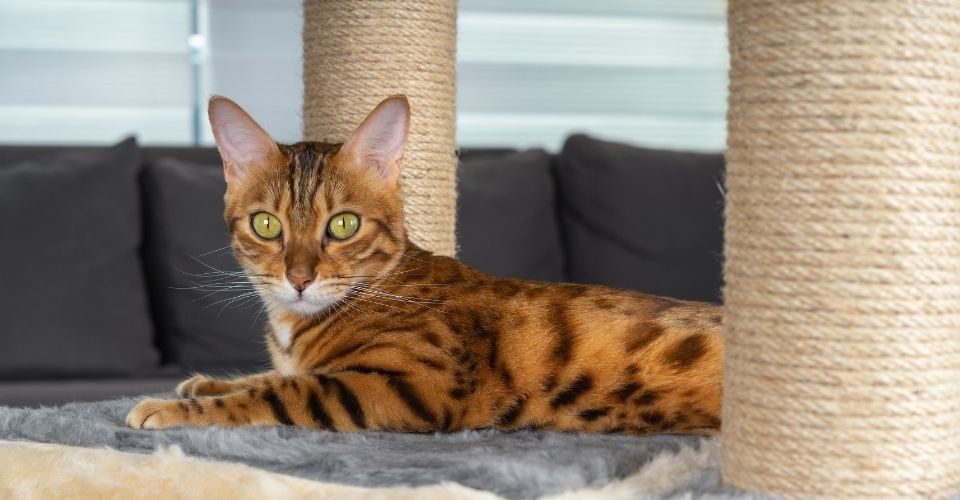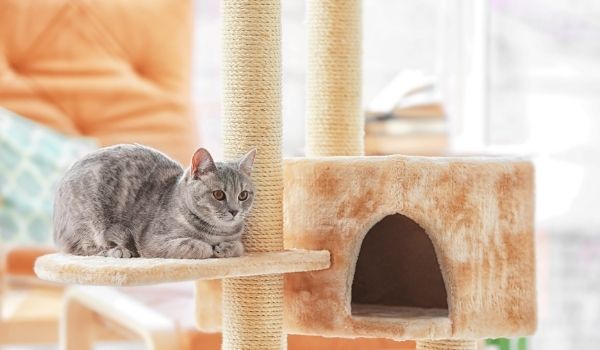Being a cat as a pet is all fun and games until it starts scratching your favorite furniture. Imagine upholstering your favorite furniture, and then out of nowhere, your cat comes and begins to sharpen her claws with it. You try to shoo it away too but sadly, there is no success.
We understand how frustrating it can be; we have been there. And we also understand that you cannot live without your furball. So, are you wondering how you are going to fight this challenge? How to keep your cat off the furniture?
Let’s dig in.
Ask Yourself These Questions
First of all, we would recommend asking yourself a few questions. Why is your cat scratching the furniture? When does your cat usually scratch the furniture? Observe how your cat scratches the furniture.
Answers to these questions will do magic. Not only will these help in training your cat better, but they will also give you a better understanding of your cat and her behaviors.
Why Do Cats Scratch Furniture?
It could be due to multiple reasons. For instance, it could be a one-time behavioral issue, boredom, frustration, an act of revenge, or a lack of training. Usually, most cats begin to scratch the furniture when they do not have enough exercise and mental stimulation. So, make sure you provide your cat with enough activities to keep herself and her mind busy.
In this article, we will suggest different ways to help you keep your cat off the furniture.
11 Ways To Keep Cats off Furniture
If you have tried everything and nothing works, here’s what you can do to protect your furniture from creatures that live by their own rules—cats. If one of the below ways doesn’t work, don’t give up. Stay positive and try the next one.
Use Aluminum Foil
Remember, cats scratch furniture because they like the feel and sound of the wood. So, try covering your furniture with aluminum foil as most cats don’t like the sound and feel of it. Rather, some cats are even afraid of aluminum foil. Cats avoid slippery surfaces, and aluminum foil can work as a great cat repellant. However, this trick might not work for all types of furniture and with all the cats, as some are stubborn and won’t give up.
Use Plastic Carpets or Mats on Furniture
Jumping on plastic carpeting can be a bad experience for your cat because it has those little numbs. Take full advantage of this and cover your couches and tables with plastic car mats or carpets. It can easily annoy your cat. The results of mats may turn out to be spectacular.
Cat Scratching Post
Cats love to jump and climb, which is why they should have a cat tree or cat scratching post. When you give your cat a specified area for such activities, she will automatically avoid scratching your furniture. Not only will this fulfill all their scratching desires, but it will also allow a safe, natural, and friendly climbing—or scratching—place. Get them a cat tree or a scratching post and let her relish her wild instincts. Check out the products below; they are attractive and neutrally toned to fit any décor.
Use Squirt Bottle of Water
This trick works like magic, and it’s pretty simple, easy to use, and quite economical. Spray your furniture with a squirt bottle full of water. Since cats are often afraid of water, this will tell your cat that it is not a place for them to be. At the same time, make sure you don’t spray excessive water as it can swell up and damage your furniture.
Home Remedy
Try this simple and easy home remedy of a homemade spray. Apple cider vinegar spray is going to make a safe cat repellent that can help you like anything when training your cat to stay off the furniture. All you need to do is to mix water with apple cider vinegar and spray it on the parts of furniture your cat loves to scratch. When you are done, wait and see the magic.
You can also save the orange and lemon peels and then rub them gently on the furniture parts. Cats hate citric smells like that of orange, lemon, and vinegar.
Make sure to do a small patch furniture test before spraying all over to see if the spray damages your furniture or not.
Shoo Them by Making Noise
Make big impact noise when you see your cat scratching your furniture. This will help you scare them and shoo them away without hurting them. Stay consistent. Whenever you see her, make noises, and she will eventually understand.
Use Double-Sided Tapes
Double-sided tapes can be really helpful. Cats hate stickiness, and the double-sided tape does the job well. Cover your cat’s favorite scratching spots with double-sided tape. Not only is it affordable, but it is quite easy to use as well. The only problem with this hack is that it may need frequent replacement. Other than that, you are good to go.
Move the Furniture
If you want your cat to stop scratching your furniture, you really need to make the furniture less appealing. Just sit there and think, why is this piece of furniture attractive for your cat? Is it near the window? Is it a sunny spot? If yes, then change the location of the furniture and place your cat’s bed or cat hammock in that location so that they can enjoy all the sun they want. If it is difficult to move the furniture, keep the blinds closed if it is near the window. Don’t place cozy paddings on the furniture like blankets and soft cushions, and don’t place food on the kitchen counter because all these things attract cats.
Never Feed Your Cat on Furniture
Make sure to never feed your cat when it is on furniture because this gives a signal to your cat that food and furniture go together and are a great combo. Rather, feed your cat in her own area where you want her to be.
Train Your Cat
Cats are very intelligent creatures that can be easily trained. Try to train your cat manually. By using squirt bottles, training becomes a lot easier. This will help in telling your cat where she is allowed and where she isn’t.
Another way of training your cat is to create built-in punishments. Always stick to positive reinforcements. Never punish your cat yourself; cats can become very aggressive if punished. Rather, trick them by placing some lightweight cookie sheets at the end of your furniture near the edge. When your cat tries to jump on it, it will automatically slip. This will discourage your cat from jumping or scratching furniture.
At the same time, reward your cat’s good behavior. This will stop her from misbehaving.
Give Your Cat Plenty of Playtime:
Cats love to play. Give them all your attention and enough playtime to exert their energy. Give them toys, boxes, and tubes that are their favorite. Make sure your cat is indulged in healthy activities. Encourage your cat to be playful—but not with furniture.
Don’t Declaw Your Cat
No matter how frustrated you are by their scratching habits, never think of declawing your cat. Although it may seem like a very easy solution, it is a very horrific experience for your cat, and no cat should go through such trauma. Their claws are their defense weapons; never take them away. Declawed cats have a hard time walking and can bring in them a lot of aggressiveness.








